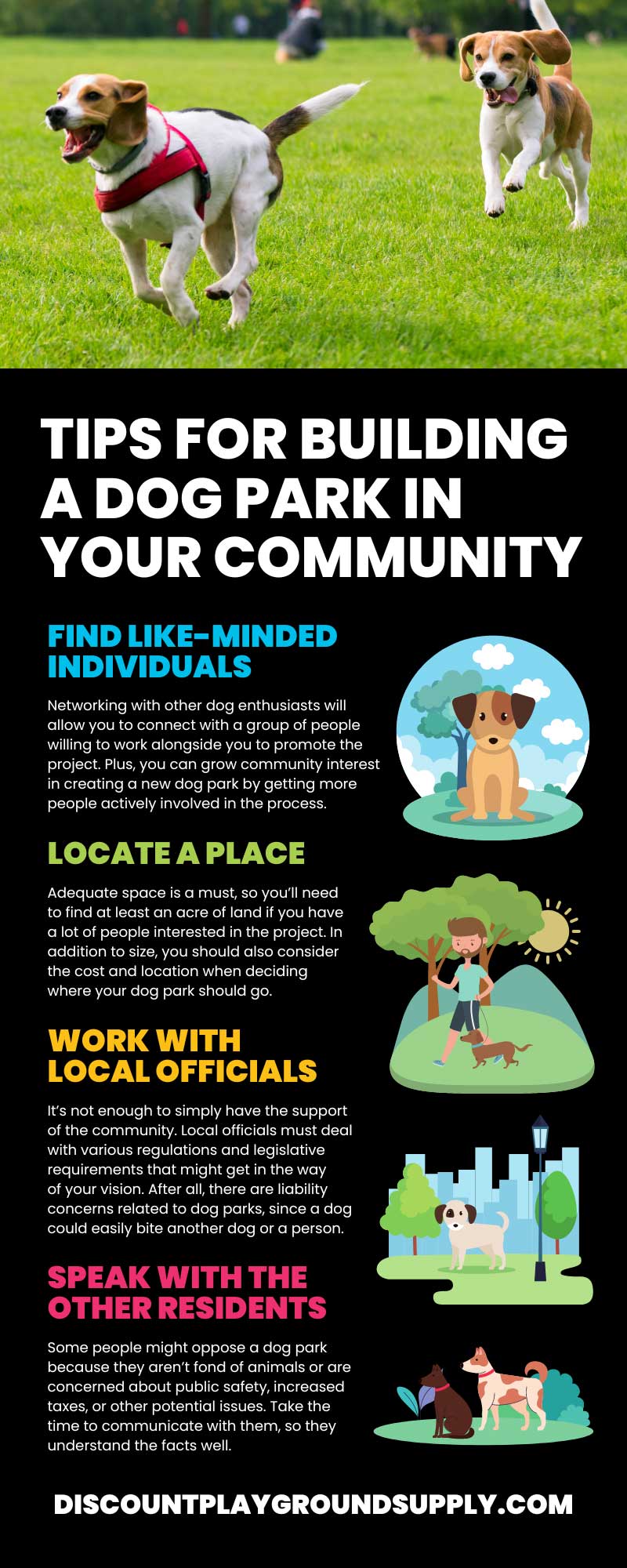Owning a dog can be a joy, but they’re usually active creatures, and many people don’t have a good outdoor place to bring them. Dog parks have become popular attractions because they give your pet a chance to be active and socialize, which is essential for a long and healthy life.
If you don’t have a dog park in your area, you should consider starting a local project. Here are ten tips for building a dog park in your community to begin.
1. Consider Your Options
Before committing to a long-term project, consider your available options. There might already be spaces for dogs to play in your area that you didn’t even know about. In some cases, you might find someone with a large property, who allows other dog owners to come and let their animals loose. Do some research beforehand to see if there are any similar hidden gems you’ve been missing.
2. Find Like-Minded Individuals
Community projects can be a handful. If you decide to go forward with building a dog park, you should try to find a few other dog owners in your area that can help get things going.
Networking with other dog enthusiasts will allow you to connect with a group of people willing to work alongside you to promote the project. Plus, you can grow community interest in creating a new dog park by getting more people actively involved in the process.
3. Locate a Place
With a support network in place, you can work together to find a few good spots that are available for use. Finding a plot of land properly zoned for a dog park can take time, but if you stick with it, you might just find the perfect spot.
Adequate space is a must, so you’ll need to find at least an acre of land if you have a lot of people interested in the project. In addition to size, you should also consider the cost and location when deciding where your dog park should go.
4. Brainstorm
Now that you’ve got some idea of where you want to build, you should take some time to consider the possibilities for your project. By coming up with some unique concepts, you can start homing in on your vision and flesh out what will and won’t work.
Here are just a few of the things you should consider at this stage:
- Whether it should be an on- or off-leash park
- Whether there will be separate areas for large and small breeds
- How waste management will work
- What features and amenities you will offer
Along with answering these questions, you should try incorporating as many natural elements into the design as possible for the best results. After all, what is a park without greenery? Furthermore, you will need to consider the equipment your park will need at this stage. For example, a reliable playground barrier is a must if you want to keep the dogs all in one place.
5. Create a Plan
Once you’ve got some ideas on the table, you’ll need to think carefully about which are actually possible and which you should discard. Create a solid plan that accounts for everything you want to do and set realistic goals to help you stay on track.
Then, go over your plan and refine anything that seems too abstract. You want to lay everything out clearly, so you have a professional presentation ready to go at a moment’s notice.
6. Gather Resources
With a plan of action in place, it’s time to get a clear picture of how much funding and resources you have to put toward the park. Itemize costs, predict expenses, and consider potential problems you might encounter to ensure you’re ready for anything.
At this point, having others to help take on some of the workload will really pay off. By working within your network, you can reach out for donations, find sponsors, or hire volunteers to help you put everything in place.
7. Work With Local Officials
It’s not enough to simply have the support of the community. Local officials must deal with various regulations and legislative requirements that might get in the way of your vision. After all, there are liability concerns related to dog parks, since a dog could easily bite another dog or a person.
Getting things through for approval can sometimes be challenging with so many moving parts. However, try not to get angry or frustrated by this process. Provide all the details you can and turn in any necessary paperwork as soon as possible, so things can go off without a hitch.
8. Speak With the Other Residents
You can do some public outreach while waiting for your community’s and local officials’ decisions. Talk to other residents—even if they aren’t dog owners—and inform them of the benefits of approved construction. By generating more support, you can increase your project’s chances of approval.
Some people might oppose a dog park because they aren’t fond of animals or are concerned about public safety, increased taxes, or other potential issues. Take the time to communicate with them, so they understand the facts well.
9. Finalize and Start Construction
Now that your project has been approved, it’s time to begin construction. Allocate resources responsibly and stick to the plan to keep things on track. Ensure you have all the proper permits, so you don’t experience delays.
Depending on the plans for the dog park, it can take some time to complete construction. Try to show the community how far along you are to ensure support doesn’t wane. In time, the entire community will have an outdoor space to take their dogs to for some needed exercise.
10. Enjoy
Even after the dog park opens for use, it’s essential to continue ensuring it receives enough support. Therefore, you should have strict rules in place that will keep people and their dogs safe while in the park.
Your local dog park is an open space that all community members can enjoy, whether they have pets or not. With the right approach, you’ll be able to use the space for years to come.
Keep Your Dogs Happy and Healthy With an Outdoor Space
You have quite a few options if you want to create a unique space for your furry friends. Reviewing the basic tips for building a dog park in your community will give you some ideas for realizing the project and motivating others to get involved.
There’s no question about it—building a local play area for outdoor activities will improve your community and its dogs‘ lives, so get started building your vision today!


